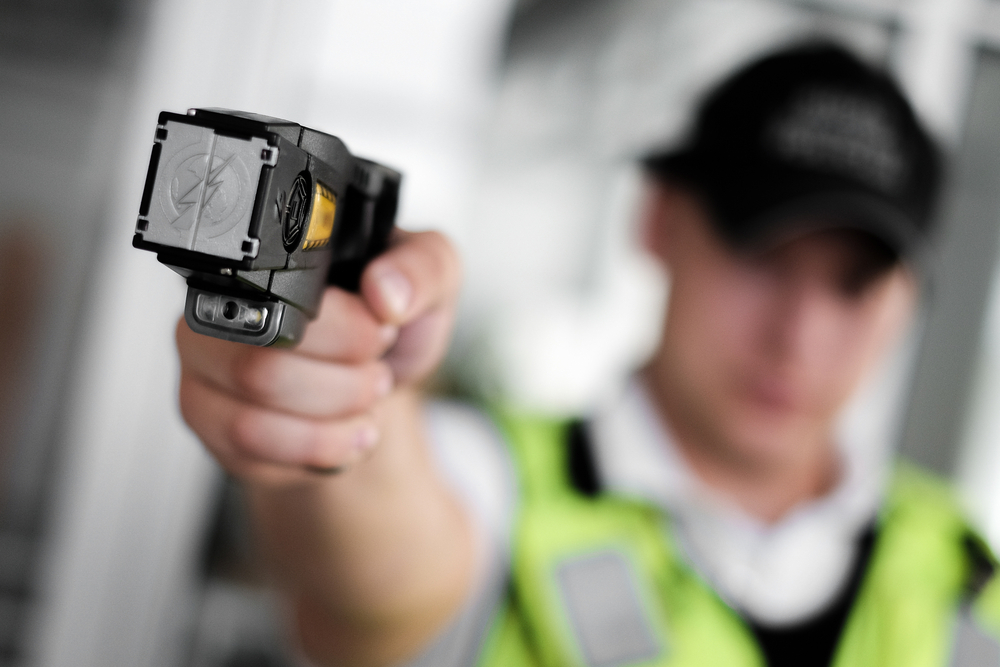
KarlisDambrans/Shutterstock
.
In August, an 11-year-old African-American girl was tased by a Cincinnati police officer when he tried to apprehend her for shoplifting. The news was greeted, predictably, with dismay by officials there.
After all, most of the public does not like the idea of a small child being subjected to police force, particularly when she was fleeing from, not advancing toward, the police officer.

Lisa Thurau
The responsible officer was put on restricted duty “pending the outcome of the investigation”; a City Council member tweeted that a child who poses no serious threat should “NEVER be tased. Period” and the police chief promised a “very thorough review.”
Equally predictably, pushback from the local Fraternal Order of Police president came quickly, reminding people that the tasing “was within our policy and procedure and guidelines.”

Diana Newmark
He was right. As it turns out, Cincinnati police policy allows the use of stun guns on children as young as 7. The vice mayor quickly introduced a motion to raise this age to 12.
The likely outcome? Odds are the police officer will be exonerated; the age of legal tasing in Cincinnati will be raised to 12; and the public will move on; at least until we read about the next incident involving a young child, a police officer and a stun gun. Then the same or a very similar set of responses from police and political figures will be duly noted by the media. Wash, rinse, repeat.
As it turns out, we did not have to wait long. In early September, a school resource officer in Smithville, Ohio tased a student who was sleeping in class.
We cannot allow these incidents to continue to happen.
Gruesome results
A common misconception among the public is that CEWs (Conducted Electrical Weapons, commonly referred to as stun guns or Tasers) provide a relatively harmless alternative to the use of force by police to apprehend or subdue resisting individuals. But not only are CEWs dangerous, and sometimes deadly, especially when directed at children, they are often used as a “compliance tool” rather than an alternative to deadly force.
Strategies for Youth (SFY), an organization founded in 2010 to promote positive relations between police and youth, has been investigating and closely monitoring the effects of CEWs on young people for several years. We have examined court cases, proposed legislation, statements from the producers of Tasers, legal actions, testimony from doctors and psychologists, and incidences of fatalities and other serious injuries caused by these weapons. We have looked closely at the physical damage these weapons inflict upon developing brains, hearts and muscles. The more we know, the louder the alarm we raise: CEWs should never be used against children, under any circumstances.
The physical evidence is gruesome. The first autopsy of three boys killed by CEWs in 2004 found that the Taser hooks had perforated their lungs, because young people often do not yet have thick enough layers of fat on their lungs to prevent perforation. In the absence of clear policies or training, police have aimed these weapons at the base of the skull or heart area of children and caused heart attacks and brain damage.
Two cases we investigated are particularly stark illustrations of how dangerous and unnecessary the use of CEWs are. In 2015, in Texas, a 16-year-old boy broke up a fight in school. A police officer tased him from behind. He fell forward and is now permanently brain damaged. In Minneapolis, a teenaged boy who was driving in his neighborhood was pulled over by a police officer. He was tased and suffered a massive heart attack. Instead of calling for an emergency medical technician, the police officer tased him again and threw him onto the sidewalk, where he landed on and broke his teeth. Now he also suffers from brain damage.
Like the 11-year-old in Cincinnati, and the teenager in Smithfield, Ohio these incidents should have been handled through de-escalation techniques. The police officers were never in any physical danger and had no legitimate reason to use Tasers on these children.
Loose rules, lack of rules
A 2011 National Institute of Justice study found that officers use their Tasers too often and in inappropriate circumstances. In 2014, for instance, the Miami New Times reported that in less than eight years, Miami Police officers used their Tasers more than 3,000 times, resulting in death at least 11 times. Many of these incidents did not result in arrests, meaning the individuals on whom these weapons had been used are likely to not have even committed crimes.
Even Taser Inc. admits that using its weapons on a child “could increase the risk of death or serious injury,” according to an instruction manual for the tool. It now describes Tasers as “less lethal,” rather than “nonlethal” weapons.
So why are police still using CEWs on children? As journalist Radley Balko noted, “The problem isn’t cops breaking the rules — the rules themselves are the problem.” And the fact that there often aren’t any rules is even more of a problem.
SFY’s 2017 report, “Where’s The State?” documents the absence of law enforcement agency policies and practices regarding its treatment of youth. The report recommends that state agencies convene groups of experts and stakeholders to develop enforceable standards for police officers who interact with youth that reflect current scholarship and knowledge about best practices. This is common practice for educators, child care and health care professionals, yet today only five states have done so for police. None of these are binding, nor have they been updated since 2008.
It probably goes without saying that Ohio is not one of the five. According to the state attorney general’s office, Ohio “does not offer guidance to officers on Taser use.”
If there is a silver lining here, it is that the child in Cincinnati wasn’t seriously physically harmed and her experience can serve as a cautionary tale, preventing worse tragedies from occurring, particularly as millions of children are in school.
Risk high, response tepid
Data from the 2017 Indicators of School Crime and Safety indicate that almost half (45.6 percent) of secondary schools, and almost 3 out of 10 (28.83 percent) of primary schools have security staff armed with a CEW at least once a week in school. The risk that some child will be seriously injured, or even killed, as a result of this weapon is simply too high to ignore. In fact, in Fairfield, Ohio, just north of Cincinnati, a student was hospitalized in 2015 after a school police officer accidentally tased her.
Nationally, we must stop viewing these incidents as the actions of “rogue cops” in need of discipline and recognize that they are manifestations of large, systemic problems that require large, systemic responses. When police are granted access to lethal weapons and allowed to use them without training, policies or standards, this is exactly what we should expect.
Just as “thoughts and prayers” are not sufficient responses to gun violence in schools, a Twitter reaction of shock and alarm, followed by a proposal to tinker around the edges of a very bad policy, cannot be considered “action.”
We know too much about the harms of using CEWs on children to let such a tepid response slide. So far, only New Jersey has banned CEWs, though 30 pieces of legislation urging its prohibition on children, especially in schools, have circulated in state legislatures since 2005. These need to be approved quickly, and others introduced.
The only way to prevent future tragedies is to consider the evidence and acknowledge there is only one reasonable solution. We must ban the use of CEWs on children, up to age 18, by police. Period. All the rest is, as they say, sound and fury, signifying nothing.
Lisa H. Thurau is the founder and executive director of Strategies for Youth, a national nonprofit training and policy organization dedicated to improving police/youth interactions and reducing disproportionate minority contact.
Diana Newmark is a Climenko Fellow and law lecturer at Harvard Law School.































